
Next week in the Fundamentals eCourse, we turn to making dairy kefir. Delicious, thick milk kefir is one of my favorite real foods, hands down. You probably know that because I talk about it all the time. 😀
I have a plethora of grains; I’ve been raising them up to share with eCourse members. However, I couldn’t raise enough because the eCourse is quite full.
But back to those dairy kefir grains. I asked Julie at Cultures for Health how to dehydrate kefir grains, because I figured they’d ship much more easily if they weren’t wet. She gave me very simple instructions, and that’s the point of my post today.
Why Dehydrate Kefir Grains?
You might wonder why’d you want to learn how to dehydrate kefir grains. For one, if you want to ship them. 🙂 But two, and much more personally practical, you should dehydrate grains as backup cultures for the future. Perhaps your raw milk source dries up and you need to save grains for when milk is in season again.
I’ve read that grains don’t all revive (one source said 40% viability), so it is a good idea to put back several kefir grains. Dehydrating is not the only way to put back grains, though. You can keep grains in the refrigerator in a small amount of milk that you change weekly, or you can freeze grains as-is (wet). Finally, and the topic of this post, you can dehydrate them.
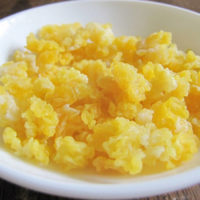
How To Dehydrate Kefir Grains
Instructions
-
Rinse the grains thoroughly with good water: well water or mineral-rich spring water.
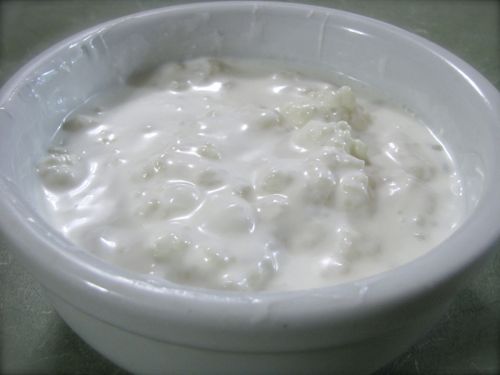
-
Don't use chlorinated city water.
-
Water from a filter is okay, even though it strips out minerals; as minerals are not so much of a concern for making the grains dormant.
-
Lay out to drip off on a clean towel or paper towel.
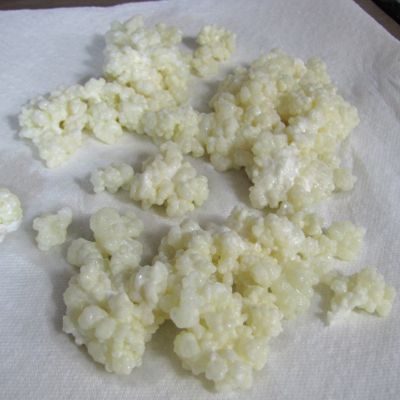
-
Lay the grains on a piece of unbleached parchment paper, cover with a loose paper towel (to keep dust off), and dry at room temperature until they are hard and yellowish.
-
Or use an Excalibur dehydrator at the lowest temperature. The ParaFlexx sheets will work, too.
-
I chose to use parchment paper because I knew it was sterile.
-
Turn the dial to where it barely turns on. According to Julie, this is the perfect temperature.
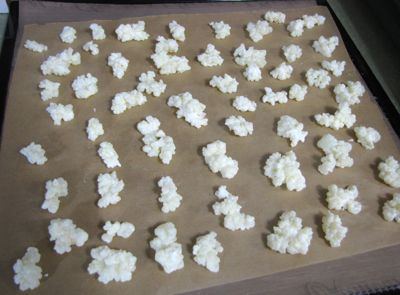
-
Drying time will be 3 to 5 days for the largest grains; smaller grains will be done sooner.
-
Store in cool storage, the refrigerator, or freezer when dry.
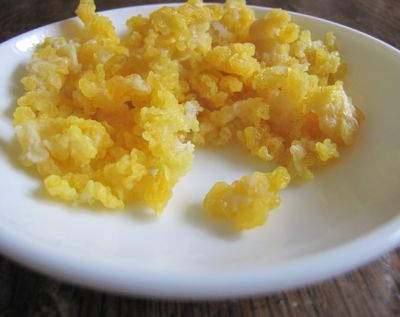
They look much smaller now, don’t they? Yellowish — no, quite yellow! — and all shriveled up. Tomorrow, many of them will be off to Traditional Cooking School members.
Wondering if kefir is for you? Have you seen my 7 Yummy Ways to Eat Kefir? I can almost guarantee you’d like some or at least one of those uses!
How do you save your cultures for the future, whether dairy kefir, water kefir, Kombucha, sourdough, whey, or other?
...without giving up the foods you love or spending all day in the kitchen!

2 free books:
Eat God's Way
Ditch the Standard American Diet, get healthier & happier, and save money on groceries...
We only recommend products and services we wholeheartedly endorse. This post may contain special links through which we earn a small commission if you make a purchase (though your price is the same).


Wardee, how do you rehydrate them? Can they just go straight into milk? I expect that first batch would take longer to kefir.
Betsy – You put the grains in small amounts of milk, which you change daily until the grains are plump again and producing kefir. It can take several days up to several weeks. Then you use the grains in a full batch of kefir.
Can you freeze dry the grains?
Hi, Annie.
We have not tired this
You may want to check with someone who does freeze drying like Laurie at commonsensehome.com
~ Danielle, TCS Customer Success Team
I dehydrate water kefir grains much the same way to keep for back-up and to share with friends. Rinsing is a vital step so they don’t dry sticky. They hydrate nicely, but the first couple of batches tend to be rather thick and syrupy in texture (the actual water, I mean). Not sugary syrup, just like I thickened the water for a thin gravy. Not real appetizing. I’ve found if I keep making the water kefir they do just fine after (tossing) a couple of batches, but am wondering if you or Julie (if she joins us here…hint, hint!) will be able to shed some light on that one.
I’ve also dehydrated milk kefir grains and was pleasantly surprised at the beautiful sunny color of my grass-fed milk/cream! I haven’t hydrated them yet…but I will soon just so I can see how they do. I’m fascinated by the whole process!
Nancy – Wow! I never though of sunny kefir! Are you using Jersey milk? Our goat milk kefir is white as snow. 😀
I’m glad to hear this works on water kefir grains too. I killed my grains during my whole morning sickness/let’s move across the country season last fall. When I get around to ordering new ones, I will definitely try to expand and save a back-up batch. Both my husband and I miss having kefir juice around.
Also, the RFW link you put up is not functioning properly. I thought you might want to know.
Just wanted to share my experience…I have had my grains for about 3 years now, and have on two or three occasions left them in milk in the refrigerator for ::ahem:: 4-6 months at a time. They have come back from dormancy all three times and produce beautiful, thick, sweet kefir still! So, if dehydrating seems a bit much, I’ve had great luck good ol’ fashioned neglect. =)
My friends grains died after only 4 weeks in the fridge in milk…..
You have to change the milk out! Yes the grains ate the lactose slower but when it runs out, they will starve. In fact, my grains make beautifully thick, sweet and creamy kefir in the fridge while the grains on the counter make grainy, sour and separated gunk.
Oh i thought you meant without changing the milk. I know you have to change the milk.
Too many grains / time on counter. Cull them down or reduce time to second ferment in fridge.
The kefir making don’t necessarily need to go through “to completion” all it needs is a reasonable time then the inoculated milk will continue on its own to ferment.
If they are near a heat source say like next to cooking they can go from 24-48 hour down to 6-12 instantly.
Hey, I keep mine in the fridge all the time when I have too many and they are eating me out of house and home. How often do you change the milk? Right now I am changing it out every week, but I find the kefir they are making is very very liquidy and yeasty…maybe im not leaving them in the same milk long enough? Thanks!
I’ve had same problem at times. Sounds like you got bunches, back off, rinse grains in milk daily and after 4-5 days if not improving, rinse on high content mineral water or well water Or instead may try tiny pinch salt like Redmond or sterile egg shells in the batch once or twice.
Also depend time volume food-sources & temps Etc each part of the colony is favored. My woman and I favor flavor of our grains at 76 F for 18 hours at constant temp. We also like it in the 54-68 F range for 2-3 or more days Or a fluctuating temp from 68-86 F for between 6-24/36 hours depends on where temp or how it was allowed to fluctuate i.e. Next to pot hot water on counter while making tamales after a cold night and cool day. Each little beneficial good guy in the colony will be producing more or less than the rest of the colony depending food source and Yes Temp.
Rinse each grain by hand in 40 F or cooker milk until it’s clean, just barely cover with milk, one time fridge next time not, make them fight with temp volume and time between each rinse – they are hearty – and even something like yeast in sir good or bad will effect them, one time had a batch too much kefiran and just sitting on counter next to another batch balanced them both out in one couple minute exchange, and had similar experience with an experiment batch which I was Killing with the experience and changing the soap I washed my hands made those guys bounce back.
I’ve had other problem grains and always it’s been the volume milk and they love goat or being bathed in a farm bought kefir from goat say an ounce or two in with new milk while on cow milk or even mixing or alternate cow goat. Mine love any milk but seem to do better in raw yet there been times they over produce in store bought.
I bought some keifer grains last yr., tried to make keifer about 4 times, I did not like the smell ,kind of a mild mildew smell. Anyways, I placed them in some milk and stored them in the fridge. Well I just took them out and they haven’t grown ,look yellow, so i’m wondering if they are still good? Any help would be appreciated.
Megan – So funny and good point. I would agree, many of these cultures we use in traditional cooking are quite hardy!
Thanks, MacKenzie – I fixed it. 😀
I guess I said that wrong…the kefir is white, but the dried grains were yellow (like your picture).
Yes, my milk is Jersey…all that cream makes me a happy woman! 🙂 And while the kefir itself is also white, it’s not as snowy as goat’s milk kefir, for sure. Aesthetically I really prefer goat’s milk kefir over cow’s milk. I just meant that when the grains dried to a sunny yellow I was pleasantly surprised! I assumed they dried yellow because of the hue of the cream in the milk that it is from grassfed cows. Does that make sense?
NancyO – I understand now. 🙂 But it must not be the Jersey cream that makes them yellow, because mine are yellow, too. And quite yellow in fact, even though the goat cream is snow white. It is amazing – like a science experiment. I’m jealous of your Jersey milk. We are thinking about getting a cow, but waiting for the Lord to make it happen when it is right/if it is right. I get local Jersey cream, but Daisy (that’s the cow’s name) is dried up now, so we’ll have to do without for many months. I can’t figure out why she’s being dried up now, during the season for grass-fed cream!
I didn’t know goat’s milk cream is so white…I guess that confounds my theory! Yes, the science is interesting. I am very blessed to be part of a cow sharing program, and get several gallons of milk a week, but can’t get just the cream…unless I skim it off my own milk. My farmer friends also have goats, but only enough to help out a few families who have specific needs for goat’s milk. Our own cow would be nice…but my sweet husband isn’t inclined that way. He’s inclined to buy from farmers who ARE inclined that way though, so I’m thankful for that! ;D So sorry about your cream source…that’s a hard one. You do need your own cow!
Nancy – Just to show you how white it is, take a look at this post. It has a picture of the butter I made from goat cream:
https://traditionalcookingschool.com/2009/06/22/homemade-cultured-butter-from-cultured-goat-milk/
See? White as snow! It was amazing butter, too. 🙂
You and your husband have a great arrangement – if we can’t do it ourselves, it is wonderful to support others who do.
How long do grains last in the refrigerator? Someone gave me kefir grains in a styrofoam cup and plastic bag almost 2 months ago; I placed it in my refrigerator and forgot about them. I have never used kefir so I don’t know what to look for. They aren’t yellow, but white.
I’m also wondering how you skim off goat milk cream. We are milking our goats again, but it seems next to impossible to take the cream! We also have a Jersey cow we are milking, so I am dealing with about 4 gallons of milk per day, with the addition of the goat milk!
Wardee,
Thanks for this information. I should do this for my back up grains that I don’t have to
worry about. (Yes, I worry about my kefir grains. I call them “my kefir babies” because you do have to worry about them just like babies. LOL
However, I think the grains just might ship easier in a wet, more pliable state. Just put the wet grains with a small amount of milk in a small Zip-Lok bag, being sure to press out all the air you can. Seal it well and place it in a small bubble envelop. My grains were shipped this way and they were good to go the minute I received them. They did just fine.
Wardee…my farmer friend says the yellow is from the beta carotene in the cream of both milks. She said goats use the beta carotene more efficiently than cows do, so their milk and cream is whiter, but evidently it’s still there in amounts that show up when the kefir grains are dried. That’s a start on the science….
I’d just like to say how nice it is to be among people discussing my beloved grains. Just their mere mention around my parts, let alone how to protect the flock for the long haul, has gotten me nothing but “weird” looks and my ever favorite…”There goes Jed again talking about weird foods.”
I thought once probiotics had broken into the mainstream (haven’t they?) everybody would turn a new leaf towards me and I might actually be viewed as a valid resource. Well…not yet in these parts of suburbia.
So, sorry for going off track a little but I did want all of you to know how happy it makes me feel to read your post concerning kefir and the like. I’ll keep raising my grains, etc and be ready for when the masses come calling.
🙂
Jed,
Just wanted you to know that you are not weird—all those other people who don’t understand our precious little kefir babies are the weird ones! 🙂
Anyway, I simply adore my kefir babies. I tend to them just like babies, making sure they’re well-fed and have the right temperature, etc. They give me such yummy kefir milk and I appreciate it so much with each swallow. And I have been rewarded with excellent health this past winter. I owe them so much. Now don’t go thinking I’m weird. Remember, it’s those other people who are weird. LOL
I have been searching High and low for someone with water and or dairy kefir grains with no luck. Do you have any left/available?
Hi, Teri! I emailed you. 🙂
am dehydrating some milk kefir grains now.. in my excaliber @ 85 degrees. they are already very very yellow after only a few hours.
When I dried out my milk kefir grains, I covered them in dried milk powder in a jam jar. I also thought I would be reviving them within a few months. Then I lost them in the cupboard. Two years later I find them. Within eight days they are thickening up milk nicely. Tough little critters!
hi…
does any body knows how to dehydrate kombucha culture?
thanks in advance
Hi! I have too many grains. Does anyone know any good grain recipes?
Do any of you have experience sending dehydrated kefir grains abroad? I have friends in Mexico who tell me it’s virtually impossible to find grains anymore and they are begging for some. We tried sending some through friends who came and went back, but the agriculture department found them in the luggage and called the space-suit crew to seize them 🙁
Or are there any sources in Mexico to buy from?
Love my kefir babies too so I’m on the receiving end of weird looks as well when I talk about them or the foods I make, lol… Oh well…
Hi! My happy abundant kefir grains need to take a break in the frig, but I am all out of raw goat’s milk which is what they are used to. What is the next best thing I can buy at the store? Will it be store bought goat’s milk?
@Annette
Hi, you’re right – store bought goat’s milk would be the next best thing. You could also store them in cow’s milk without much issue, but it’s better to stay with the same type of milk you use normally (same mammal).
Hi, I have tried to dry some extra kefir grains and a white residue seemed to form on the kefir grains after about three days of drying. Is this mold? I don’t want to give someone bad grains. Thank you.
Ruth.
I dried some kefir grains and, like Ruth, have a white residue on some of them. I was also wondering about the smell. Mine have a strong cheesy smell. Is this normal?
I’m doing a transpacific move and was planning on using a food dehydrator to transport my kefir babies. Should i sprinkly some milk powder in once dehydrated?
I am making kefir for the first time. I received fresh grains and they are doing well. My concern is that my kefir taste too much like soured milk, not the “cultured” flavor I am used to buying in the store. I prefer the taste of buttermilk but I am having to sweeten it to drink. I am using whole cows milk letting it ferment for 24 hrs then straining. It is not as thick and creamy as I would like. Do you have any recommendations . Thank you
Kefir from a store is not actually Kefir, because it is not made from Kefir grains (the definition of Kefir)
I got some great grains and I really would like to know if I can drink it while I am pregnant and give to my 2 year old? I am going to dry some and keep some to make 1 cup a day because mine is huge right now 🙁 does anyone know if I can keep drinking it? Thank you everyone
We’re moving out of the country and I would like to dehydrate my grains and take some with me. How do you suggest storing them for travel once they’re dehydrated? Thanks so much for your advice!!
Joe, my family is getting used to my weirdness. We call my cultures my food pets. 🙂
I have some tiny Rubbermaid containers that were intended for transporting salad dressing. I put the extra grains in there, cover with. Little fresh milk and freeze it. I usually forget about it until the next time I have too many grains, than I pop out my little kefir cube, stash it in a plastic bag in the freezer, and start again. It takes only a minute, allows me to divide my grains as often as I’d like because it takes care of a small amount, I don’t have to haul out and run a giant dehydrator. The grains take almost no readjustment period to get going again, either.
Of the several methods described, this freezing sounds the simplest. I am going to try it before we do extended traveling.
Do you have to have a dehydrator to dehydrate the grains or could you just dry them out in the air for a few weeks?
Good to know! I’ve had to re-order grains a couple of times now, but hopefully no more.
I also make fruit leather in the dehydrator and generally ferment the puree in water kefir to reduce the sugar a bit. I’ve often wondered whether any of the probiotics survive the dehydration process. Nice to know that some probably do!
Wardee!
A question and a personal experience with the grains.
Question: What temperature do you use with the excalibur dehydrator? I wonder because it seems to me (looking at the equipment) that the lowest temperature you can have is 95F. below that the dial shows that between 0 and 95F the dehydrator is off.
Experience:
I left the grains for almost one year and to be honest i only changed milk a couple of times. Then I decided at the begining of the year to make small batches of kefir even 250 mils daily using the airlock system in a fido jar.
I believed that I could “resucitate” the grains and in fact they “came back to life” producing a very creamy and thick yogurt.
To my surprise, I decided to take these apparently “;live yogurt” to my holistic doctor who uses an equipment to measure the frecuency of living organisms using something like a Quantum Physics little machine. The doctor’s answer was: “the grains are dead” How can they be dead if they are producing a beautiful and creamy yogurt?. I decided to buy new grains and I did a small experiment in the kitchen. I made kefir in two different container with and withour airlock. The two containers produced beautiful yogurt however the container withour the airlock (only fermenting with a cheesecloth on top) produced a runny fermented milk. The kefir from the airlock jar was very creamy. I took the two containers to the Doctor and he found that they were alive.
so To briefly summarize this: “Kefir are such an interesting grain. even if they are “dead” according to my doctor they were still producing creamy yogurt but the lactobacillus were not there.
Is it OK if the drying grains have tiny white dots on them?? (or is this some kind of mold?) Drying mine for the first time…
I kept some in the fridge over the winter, but was not great about how often I fed them… Come spring time the kefir they made smelled off and was thick.
Same thing with mine. I dried my first batch in the Excalibur…they did great, beautiful yellow, no white spots. The ones I’m drying now on countertop have the white spots/powder and a few that have dried all the way are a little more brown then yellow. I was just about to throw them away unless I can find out they’re okay. Can someone please answer this question? Several others have asked but no answer yet. Thanks!!!
Can I dehydrate my milk kefir grains on the proof/dehydrate setting, 85 degrees, in an electric Wolff oven?
Hi Wardee,
I have kefir grains and my batch has grown. I had to downsize the batch and took some out and I wanted to dehydrate them, but it was in a morning when I was in a rush and did not have time to re-read your article to see exactly what I need to do. So I just took them out and didn’t rinse them, I left them kind of spread out on a paper plate with a plastic wrap on top, not tightly. Foolish I know. The next day, because I neglected getting to them, I took them and rinsed them but they smelled acid-y and fermented-like. I rinsed them with good mountain spring water.
My question is, do you think they are ruined now? Should I discard them and try to dehydrate again later with another batch?
Thanks for your help!!
Rebekah — I think they’re probably fine. I would put them in milk to refresh them, and then begin again to preserve them. 🙂
Hi Wardee,
Thanks so much for your prompt reply! I think they’ll probably going to be fine like you said, they’re starting to turn yellowish.
I have a question – we purchased a Harvest Right Freeze dryer last fall and we have been experimenting with everything. I see that one suggestion was freezing and of course this conversation was about drying them. Since the nominal shelf-life of Freezed-dried food is 25 yrs with proper packaging I am hoping you tell me that the grains should do well freeze-dried.
Hi Lea,
We don’t know much about freeze drying. Kefir starter (the powder) is freeze-dried and it still makes kefir. So it’s possible that freeze-dried grains will, too, but we can’t say for sure.
Millie
Traditional Cooking School
Can I dehydrate water kefir grains in the same way?
Hi, Phyllis.
Yes, you can use the same process with water kefir grains.
~Danielle, TCS Customer Success Team
I love regular Kefir…
As a chemo patient, liver health is extremely important. Limited testing shows a liver health benefit from 30 minute boiled, dehydrated Kefir milk. Apparently, even the dead bacteria are beneficial. Don’t take my word for it.
Ref. Nutrients 2018, 10, 862; doi:10.3390/nu10070862
Thank you so much for sharing it was very helpful! Your work is much appreciated Jess
What is the best temperature to dehydrate the milk kefir grains. I have cosori dehydrator and the lowest one I have is only 95 deg. Farenheit. Thanks.